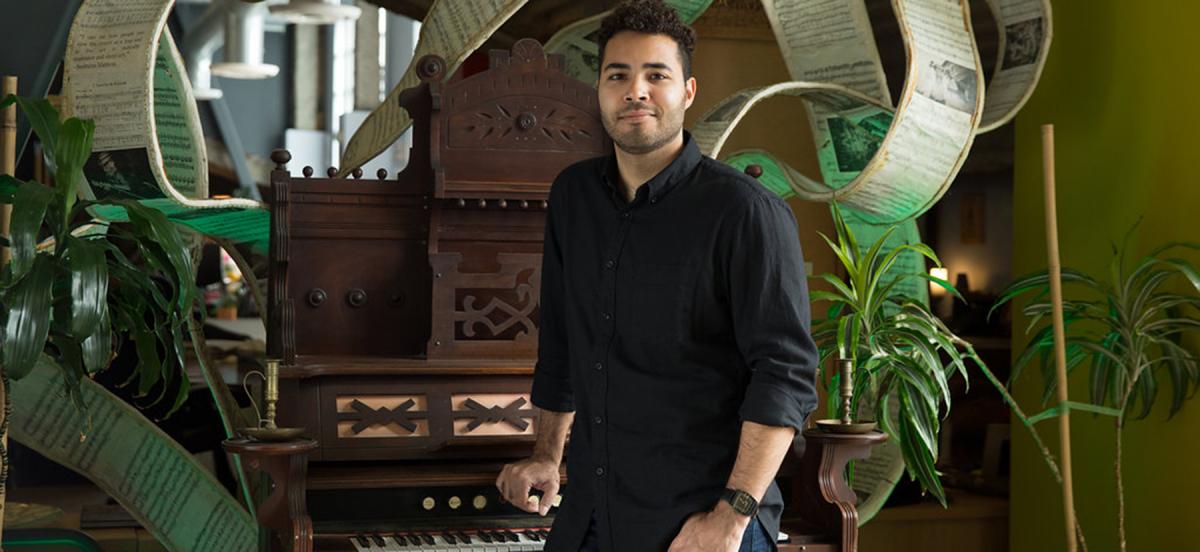Managing Burning Man

We Dominique Debucquoy-Dodley '11 at Burning Man Project's San Francisco headquarters. Photo by Angela DeCenzo.
Details
Beyond the famous Burning Man Festival, Dominique Debucquoy-Dodley ’11 works year-round to organize artistic and cultural programs for the San Francisco-based nonprofit Burning Man Project.
The only items for sale in Black Rock City are coffee and ice. Built in northern Nevada’s Black Rock Desert at the end of August every year—then dismantled one week later—this city is unlike any other. Rather than office buildings, storefronts, and restaurants, its roads are lined with camps offering wares and services, free of charge. A group slinging homemade pancakes might operate between one demonstrating basic welding skills and another teaching beginner guitar lessons.
Black Rock City and the activities that take place within its roughly seven-square-mile boundary constitute the Burning Man event, a difficult-to-describe phenomenon that draws more than 75,000 participants from around the world. Distilling Burning Man’s abstract essence into words is a challenge tackled frequently by Dominique Debucquoy-Dodley ’11, communications manager for Burning Man Project, the San Francisco-based nonprofit that runs the event and spearheads many other cultural, educational, civic, and artistic programs year-round. He oversees communication efforts related to all of the organization’s initiatives, but devotes the most energy to Burning Man itself, managing components such as press admission, social media channels, and volunteer groups.
"Burning Man is not just an event in the desert—it’s a global, year-round culture centered around creativity, self-expression, inclusion, and making the world a better place,” says Debucquoy-Dodley, who first attended Burning Man in 2013 “and instantly wanted more.” He returned annually thereafter and between events immersed himself in the community of “Burners” near his home in Manhattan. When Burning Man Project hired him in spring 2017, he left his job on CNN’s breaking news desk, where he’d worked for six years, and moved to the Bay Area to support the movement full time.
Burning Man began on San Francisco’s Baker Beach in 1986 when founder Larry Harvey, who recently passed away, and a handful of friends set alight an eight-foot-tall wooden figure made from scrap wood, but Debucquoy-Dodley says Burning Man can’t be defined concretely. “We are not a festival,” he emphasizes. “With festivals, you buy a ticket that guarantees access to a consumer experience involving a lot of items that were pre-produced. Burning Man is not about valuing anything monetarily or telling others what they should experience. We put up a fence, some street signs, and some porta-potties and build a Man at the center of the playa [the term used for Black Rock City grounds]. Otherwise, participants bring and build everything themselves.”
By day, Burning Man (whose sold-out 2018 event ended Sept. 4) serves as a massive outdoor art gallery, with participants crafting displays that might be three or four stories high. At night, the playa turns into a music- and light-filled party. On Saturday, “the Man”—which can range in size from 50 to 80 feet tall and represents whatever participants want him to—is set ablaze during a raucous ceremony, and on Sunday the week winds down with an emotional burning of “the Temple,” a structure in which attendees have left mementoes connected to things they have lost or are ready to let go of.
The artwork exhibited throughout Black Rock City includes hundreds of “mutant vehicles,” cars and trucks that participants have transformed into anything from dragons to spaceships—or an American bison like the one Debucquoy-Dodley and his friends have fashioned from a 30-foot flatbed truck. Coined “Kindred Spirit,” the vehicle shoots lasers and blasts techno music and will make its third appearance in Black Rock City this summer.
"Burners produce art for others to enjoy. I wanted to contribute to that,” Debucquoy-Dodley says.
Above all, he wants people to know that there’s no “right way to burn.”
"Burning Man is a complex culture. If I asked every participant what it means, I’d get 75,000 different answers,” he says. “Yes, I’m the communications manager, but the Burner community teaches me how to do my job. I just have to keep my ear to the ground and poke my nose in as many corners as I can.”



